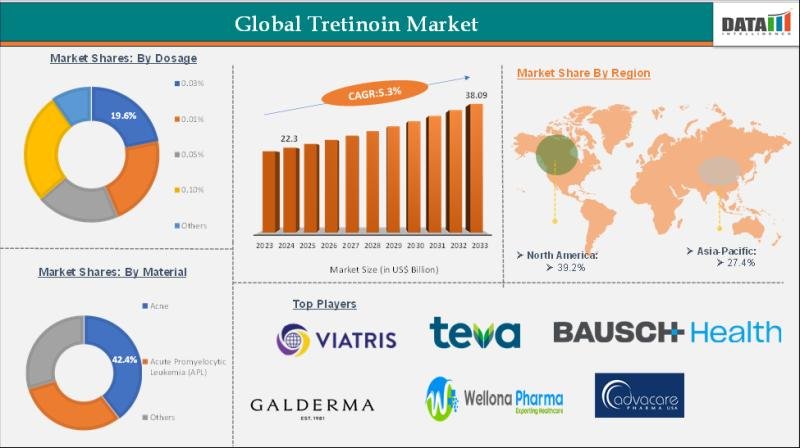The Rising Tretinoin Market: Current Trends and Future Projections
The Tretinoin market is poised for significant growth, with estimates indicating a surge from $22.3 billion in 2024 to $38.09 billion by 2033, reflecting a CAGR of 5.3% during the forecast period from 2025 to 2033. Such robust growth is being propelled by shifts in consumer skincare habits, technological advancements in teledermatology, and innovative product formulations.
Key Players in the Tretinoin Market
Several notable pharmaceutical companies are driving this market expansion:
- Bausch Health
- Galderma
- AdvaCare Pharma
- Teva
- Wellona
- Glenmark USA
- Amber Lifesciences
- Viatris
- Kavyapharma
These players are innovating through diverse formulations, expanding over-the-counter (OTC) availability, and implementing digital outreach initiatives.
Strategic Collaborations and Innovations
The Tretinoin market is witnessing a wave of mergers and partnerships aimed at enhancing product offerings and improving accessibility. Key developments include:
- Galderma’s collaboration with tele-dermatology startup Dermflix in June 2025, which aims to offer remote prescription access to Tretinoin.
- Teva’s acquisition of an Indian microsphere formulation company in July 2025, enhancing their product line with low-irritation Tretinoin options.
- Viatris signing a global licensing deal with Glenmark for novel cream formats in May 2025, targeting emerging markets.
These strategies highlight a shift towards digital dermatology platforms and the creation of gentle formulations to meet consumers’ needs effectively.
Market Drivers and Opportunities
Key Growth Factors
- Increase in Acne and Anti-Aging Treatments: Rising awareness about skincare combined with the surge in telehealth consultations is driving demand.
- Advanced Formulations: The emergence of microsphere and dual-active formulations (such as Tretinoin combined with benzoyl peroxide) enhances therapeutic efficacy.
- Tele-Dermatology Growth: Digital solutions make it easier for patients to obtain prescriptions, expanding market reach.
- OTC Availability: Partnerships with skincare retail chains have facilitated broader distribution beyond traditional health channels.
- Focus on R&D: Ongoing development of sustained-release and lower-irritation formulations aligns with consumer preferences.
Regional Insights
The Tretinoin market is impacted significantly by regional dynamics:
- North America: Leads in prescriptive use and telehealth adoption, with significant demand for anti-aging treatments (approximately $0.6 billion in 2024).
- Europe: Experiences steady growth, bolstered by increased dermatology awareness and the rise of biologic skincare.
- Asia-Pacific: The fastest-growing region, driven by urban skincare routines and rising disposable incomes, alongside new entrants in the market.
- Latin America & MEA: Emerging markets benefiting from expanding dermatology clinics and OTC distribution channels.
Conclusion
The Tretinoin market is on a promising trajectory, supported by dynamic innovation and shifting consumer preferences. Collaborative efforts among major pharmaceutical players, the focus on consumer-friendly formulations, and the booming digital healthcare landscape indicate that both challenges and opportunities will characterize the coming years.
For further insights and comprehensive market intelligence, consider exploring DataM Intelligence’s full report on the Tretinoin market.
Stay Informed
Engage with evolving trends in the skincare sector by accessing resources and market analyses thoroughly detailed by leading providers.


